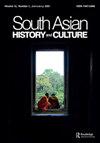The Dalai Lama and the Nechung Oracle
IF 0.3
0 ASIAN STUDIES
引用次数: 0
Abstract
A decade back, as I recall, I had befriended a Lama in Sikkim who like many of his countrymen from Tibet, had chosen to escape from the Chinese oppression to take refuge in India and be free to breathe Buddha dharma. My Lama friend only knew the Tibetan language and was immersed in his own culture, myth, mythology, and rituals. Even though he lived in this foreign land (India) and was used to meeting and greeting European visitors, he was in every sense from another world and era. Moreover this was a strange friendship as I did not know any other Tibetan and yet we could converse banal things and when we were quieter it was possible (infrequently) to have intimate spiritual discussion without any external aid. As I got to know him more I was left with no choice but to christen him as ‘Magic Lama’. Even today I vividly remember him mentioning that we usually start our spiritual journey with meditation systems that are rooted in compassion, but as one matures in faith and understanding, the inner demons opposed to spiritual attainment also become more powerful. To come out victorious and transcend all barriers one may be called to explore and practice wrathful Sadhana for the attainment of lasting peace and complete deliverance of mind. One of his parting gifts to me was an amulet to hang in my car and I could not instantaneously relate to the image of the deity on it – who looked more like a demon and I struggled to pronounce his name right. To simplify things the complicated God ‘Pehar’ was referred to me as a Tibetan deity for protection and I do believe ‘Pehar’ had come to me at a time when I needed him the most. As I started to read The Dalai Lama and the Nechung Oracle, to my surprise, the first chapter turned out to be all about Pehar, his genesis, transformation, relationship with other Gods, wrathful nature, and occult powers. Tibetan myths and practices tend to challenge all pre conceived notions and the author Christopher Bell, has made no attempt to present any concept in a palatable manner for more refined sensibilities. Bell has presented after considerable research, divergent and also conflicting perspectives on the origin of complicated God (Pehar) and the role he plays as a protective spirit in Tibet, anointed and appointed by the Tantric Guru Padmasambhava.达赖喇嘛和乃宗神谕
据我回忆,十年前,我在锡金与一位喇嘛交上了朋友,他和许多来自西藏的同胞一样,选择逃离中国的压迫,到印度避难,自由地呼吸佛法。我的喇嘛朋友只懂藏语,沉浸在自己的文化、神话、神话和仪式中。尽管他生活在这片异国他乡(印度),习惯于会见和问候欧洲游客,但从各个方面来说,他都来自另一个世界和时代。此外,这是一种奇怪的友谊,因为我不认识任何其他藏人,但我们可以谈论平庸的事情,当我们安静的时候,在没有任何外部帮助的情况下,可以(很少)进行亲密的精神讨论。随着我对他的了解越来越多,我别无选择,只能给他起名叫“魔法喇嘛”。即使在今天,我仍然清楚地记得他提到,我们通常以植根于同情的冥想系统开始我们的精神之旅,但随着信仰和理解的成熟,与精神成就相反的内心恶魔也变得更加强大。为了取得胜利并超越所有障碍,你可以被召唤去探索和练习愤怒的萨丹娜,以实现持久的和平和心灵的彻底解脱。他送给我的临别礼物之一是挂在我车里的一个护身符,我无法立即联想到上面的神的形象——他看起来更像一个恶魔,我很难把他的名字念对。为了简化事情,复杂的神“Pehar”被称为西藏的神,以保护我,我相信“Pehar“是在我最需要他的时候来找我的。当我开始阅读《达赖喇嘛和涅中神谕》时,令我惊讶的是,第一章是关于佩哈尔的,他的起源、转变、与其他神的关系、愤怒的本性和神秘的力量。西藏的神话和实践往往会挑战所有预先设想的概念,作家克里斯托弗·贝尔没有试图以一种令人愉快的方式来呈现任何概念,以获得更精致的情感。贝尔在经过大量研究后,对复杂的上帝(Pehar)的起源以及他在西藏扮演的保护精神的角色提出了不同且相互冲突的观点,由密宗大师帕德马桑巴瓦膏和任命。
本文章由计算机程序翻译,如有差异,请以英文原文为准。
求助全文
约1分钟内获得全文
求助全文

 求助内容:
求助内容: 应助结果提醒方式:
应助结果提醒方式:


